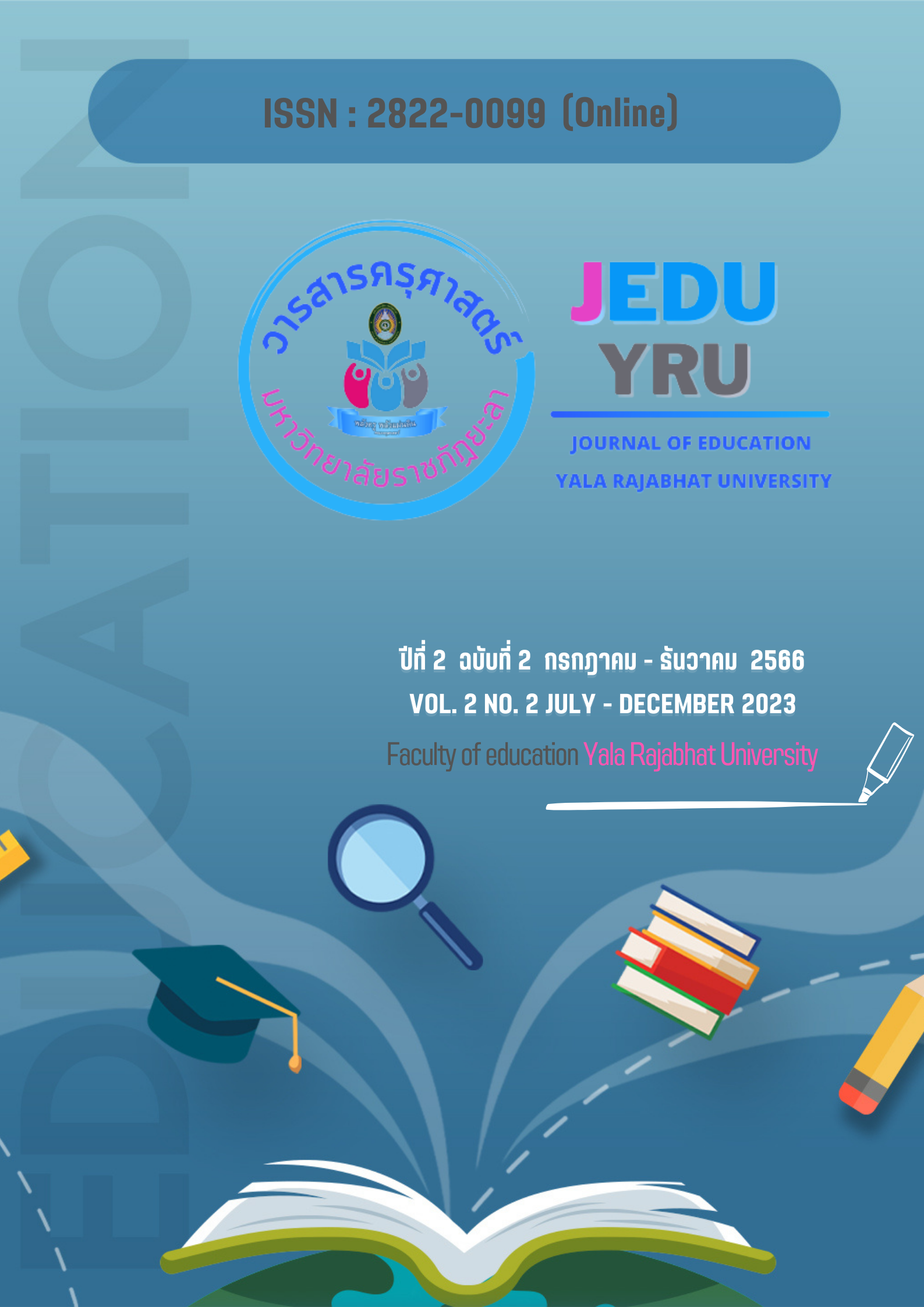The Effect of Inductive Method in Educational Application Entitled Prayer on Learning Achievement and the Memory Persistence of Primary School Students, Year 4
Main Article Content
Abstract
The objectives of this research were 1) to develop and find the effectiveness of the learning management plan entitled prayer on academic achievement and the memory persistence of grade 4 students that has the efficiency criteria at 80/80 2) to compare the pre-and post-learning achievements of grade 4 students using Inductive methods in educational applications entitled prayer. 3) to compare the memory retention of grade 4 students using inductive methods on educational applications of the prayer 4) to assess the satisfaction of grade 4 learners who use inductive methods on educational applications of the prayer. By purposive sampling, the sample consisted of 33 students at Ban Kototuera School, Raman district, Yala in the first semester of the academic year 2022. The statistics used were percentage, mean, standard deviation and t-test. The instruments consist of 1)learning management plans of Inductive methods in educational applications entitled prayer on academic achievement and the memory persistence, 2)pre-test and post-test, 3) Memory retention test (Using the same test used to measure achievement post-test), and 4)satisfaction questionnaire.The study results were as follows : the effectiveness of the lesson plan using the inductive teaching method on educational applications entitled prayer on academic achievement and the memory persistence of grade 4 students was 80.38/81.62, and the score of post-test and the memory persistence was significantly higher than before at the .01 level. The students’ satisfaction towards inductive method in educational application entitled prayer was at the high level with the mean score ( = 4.12, SD = 0.76).
Article Details
References
กระทรวงศึกษาธิการ. (2551). หลักสูตรแกนกลางการศึกษาขั้นพื้นฐานพุทธศักราช 2551. กรุงเทพฯ: ชุมชนสหกรณ์ การเกษตรแห่งประเทศไทย.
ชัยยงค์ พรหมวงศ์ และคณะ. (2556), การทดสอบประสิทธิภาพสื่อหรือชุดการสอน. วารสารศิลปากรศึกษาศาสตร์วิจัย, 5(1), 5-20.
ทิศนา แขมมณี. (2557). ศาสตร์การสอน : องค์ความรู้เพื่อการจัดกระบวนการเรียนรู้ที่มีประสิทธิภาพ. กรุงเทพฯ: จุฬาลงกรณ์มหาวิทยาลัย.
ธนบูรณ์ อินอุ่นโชติ. (2555). ผลการจัดกิจกรรมการเรียนรู้ภาษาไทย เรื่อง การแต่งกลอนสุภาพ ชั้นมัธยมศึกษาปีที่ 2 โดยใช้การสอนแบบอุปนัย. วิทยานิพนธ์การศึกษามหาบัณฑิต (หลักสูตรและการสอน). มหาวิทยาลัยมหาสารคาม.
นิรันดร์ จุลทรัพย์. (2546). “IQ, EQ, MQ : เก่ง ดี มีสุข”. วารสารศึกษาศาสตร์ มหาวิทยาลัยทักษิณ, 2(2), 29-36.
เบญจวรรณ กี่สุขพันธ์. (2546). หลักสูตรกับการจัดการเรียนรู้. กรุงเทพมหานคร: ศูนย์หนังสือมหาวิทยาลัยราชภัฎสวนดุสิต.
เบญจพร สว่างศรี. (2558). การพัฒนาชุดการเรียนรู้ด้วยวิธีการสอนแบบอุปนัยร่วมกับกระบวนกลุ่มสำหรับนักศึกษาระดับปริญญาตรี. กองทุนส่งเสริมงานวิจัย: มหาวิทยาลัยเทคโนโลยีราชมงคลสุวรรณภูมิ.
มูฮัมมัดอามีน เจะมะ. (17 ธันวาคม 2564). ครูอิสลามศึกษาแบบเข้มโรงเรียนบ้านกอตอตือร๊ะ. สัมภาษณ์.
วิมลรัตน์ สุนทรโรจน์. (2553). การออกแบบการจัดการเรียนรู้ ตามแนวคิดแบบ Backward Design. พิมพ์ครั้งที่ 4. มหาสารคาม: กากะเยียสานักพิมพ์.
วิโรจน์ ดุเหว่า. (2554). ผลการจัดการเรียนรู้เรื่องการคูณและหารเศษส่วน โดยใช้วิธีการแบบอุปนัย กลุ่มสาระการเรียนรู้คณิตศาสตร์ของนักเรียนชั้นประถมศึกษาปีที่5. วิทยานิพนธ์ครุศาสตรมหาบัณฑิต สาขาหลักสูตรและการสอน. มหาวิทยาลัยราชภัฎเชียงราย.
สายแก้ว เรืองทัพ. (2560). ผลการจัดการเรียนรู้โดยใช้ชุดการสอนแบบอุปนัยที่มีต่อผลสัมฤทธิ์ทางการเรียนและความคงทนในการเรียนรู้วิชาภาษาไทยของนักเรียนชั้นประถมศึกษาปีที่ 6. วิทยานิพนธ์หลักสูตรครุศาสตรมหาบัณฑิต สาขาวิชาการจัดการหลักสูตรและการเรียนรู้. มหาวิทยาลัยราชภัฏนครสวรรค์.
Abu Da'ud, Sulaiman bin al- Ash al – Sijistany. (1997). Sunan Abi Da'ud. Berut : Dar Ibn Hazmi.
Adams, Jack A. (1967). Human Memory. New York : McGrew-Hill Book Company.
Bellanca, J., & Brandt, R. (2010). 21st Century Skills: Rethinking How Students Learn. Bloomington.


